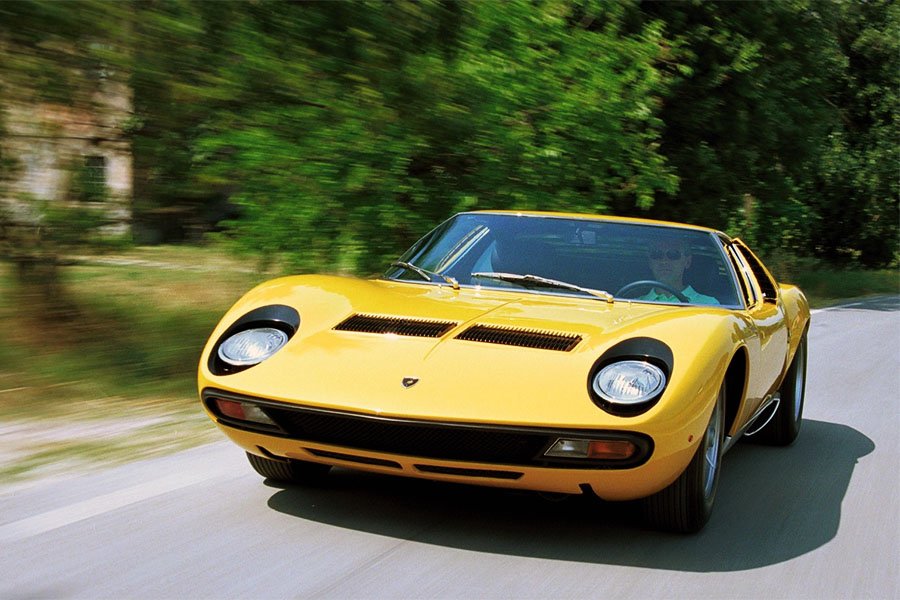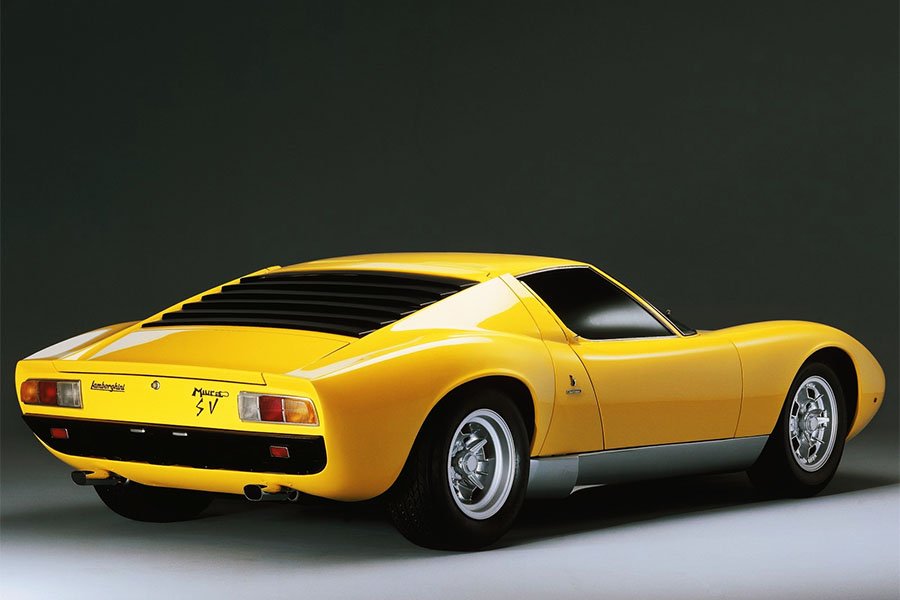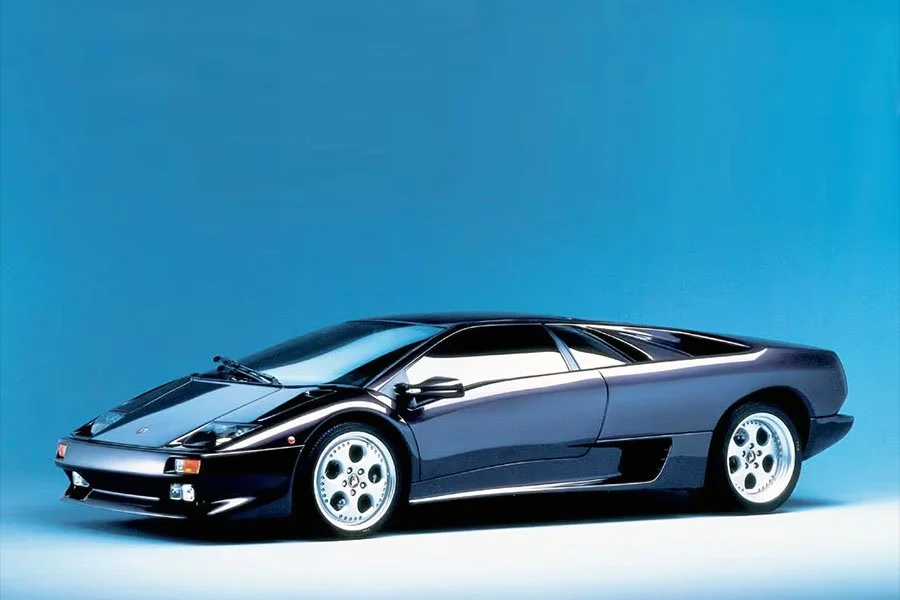Guide: Killed by the Countach - a Historical & Technical Appraisal of the Lamborghini Miura P400 SV
/BACKGROUND
At the Geneva Motor Show in March 1971, Lamborghini unveiled a third iteration of the groundbreaking Miura.
Dubbed SV or Spinto Veloce, it initially garnered little attention owing to the debut of an even more exciting Lamborghini on the Bertone stand: the prototype Countach LP500.
With its dramatic profile, scissor doors and a five-litre 440bhp V12 that was expected to provide sufficient gusto for a 200mph top speed, the Countach understandably stole all the headlines. It embraced the radical wedge design language that had become all the rage for styling concepts in the couple of years prior, but uniquely the Countach was sensationally expected to reach Lamborghini showrooms within a year or so.
By contrast, the elegantly curved Miura had been around in one shape or another for half a decade and, in the fast moving world of late sixties / early seventies automotive styling, was no longer at the cutting edge.
Since having debuted in fully clothed trim at the 1966 Geneva Motor Show, Lamborghini had already updated the Miura several times.
During January 1968 (ten months after production began), the company moved to a thicker 1mm instead of 0.9mm gauge chassis. A more powerful 370bhp Miura S then followed in late 1968 to replace the 350bhp original. The Miura S also came with uprated suspension, better Pirelli tyres and a higher specification interior.
April 1970 saw ventilated disc brakes added to the specification.
As for this latest SV incarnation, Lamborghini produced the most technically accomplished Miura yet.
To complement its even more powerful engine, the SV featured a further stiffened chassis along with uprated rear suspension, wider rear wheels, the latest Pirelli tyres and some minor cosmetic tweaks.
It slotted into a model line up that included a brace of traditional front-engined Grand Tourers: the four-seat Espada Series 2 and the shorter wheelbase Jarama 2+2.
Also in the pipeline was a V8-engined junior model with 2+2 cockpit layout that had appeared at the Turin Motor Show in November 1970. However, a series of delays meant production of this car (the Urraco, for which Lamborghini invested heavily in tooling and expanded floorspace) would not begin until late 1972.
CHASSIS
To improve torsional rigidity, Lamborghini made the Miura’s steel monocoque even stiffer than before. To accommodate wider rear wheels and reduce oversteer, the rear suspension pick-up points were relocated and new lower rear wishbones installed.
As usual, tubular steel subframes were attached at either end of the central tub to support the engine, gearbox, suspension and other ancillary equipment. A 90-litre fuel tank was located over the front axle.
The wheelbase was an unchanged 2500mm.
Chassis fabrication took place at Marchesi in Modena.
The suspension layout comprised double wishbones, coil springs and telescopic dampers. An anti-roll bars was fitted at either end.
Non servo-assisted ventilated Girling disc brakes ran off a separate hydraulic circuit for each axle. The front discs had a 305mm diameter while those at the rear measured 279mm.
Instead of 7 x 15-inch Campagnolo centre-locking wheels all round, the SV came with 9-inch wide rear rims. All four corners got Pirelli’s newest tyre compound.
ENGINE / TRANSMISSION
To eke a little more power from the Giotto Bizzarrini-designed 60° V12, the SV’s engine was modified with further enlarged inlet ports and more radical cam timing.
This resulted in a peak output of 385bhp at 7850rpm and 294lb-ft at 5750rpm.
For comparison, the Miura S had pumped out 370bhp at 7700rpm and 287lb-ft at 5500rpm.
The rest of the specification was unchanged: the engine featured an all-alloy construction with chain-driven dual overhead camshafts, single plug ignition with two coils and two Marelli distributors, wet-sump lubrication, 10.7:1 compression and four triple-choke downdraught Weber 40 IDL 3L carburettors.
Displacement was 3929cc thanks to a bore and stroke of 82mm and 62mm respectively.
Transmission was through a five-speed Lamborghini transaxle with a single-plate clutch and open differential.
BODYWORK
Although at first glance the SV looked identical to any other Miura, a couple of minor tweaks helped it stand out from earlier variants.
The most obvious changes concerned the lighting. At the front, the distinctive slatted headlight lashes were dropped in favour of gloss black-painted surrounds. At the back, bigger tail light clusters now incorporated a clear reverse lens. Separate red reflector elements (previously part of the main tail light clusters) were moved down to the hex-pattern grille.
There was also a redesigned front bumper assembly with looped corner sections that shrouded new single-piece indicator / fog light clusters. Behind the scenes was some reconfigured ductwork for improved cooling.
Down each flank, more bulbous rear fenders were required to cover those broader 9-inch back wheels.
The rest of the Miura’s trademark features were retained. They included exposed retractable headlights, upswept rear door sections with stacked engine cooling grilles, a much-copied satin black slatted rear window treatment and the aforementioned hex-patterned tail grille.
The fuel filler cap was concealed underneath one of the slatted black grilles mounted mid-way up the front clip.
Single piece front and rear clamshells were fashioned from aluminium. The doors, roof and centre section were steel.
Completed bodyshells were shipped from Bertone’s Turin facility to Sant’Agata for completion.
INTERIOR
Inside, Lamborghini moved the SV’s ignition barrel from the central control panel to the steering column and added a steering lock.
Otherwise the specification was broadly identical to the outgoing Miura S.
Directly behind the leather-rimmed three-spoke steering wheel was a 320kmh speedometer and a 10,000rpm rev counter. Each dial was housed in its own individual cowl.
The rest of the instrumentation was located in an arced centre console that swept down to join the transmission tunnel. The half dozen additional gauges were stacked in two horizontal banks of three. Read outs for water temperature, oil temperature, oil pressure, fuel and battery condition were provided along with a clock.
Switchgear was mounted on the centre console and a roof-mounted tunnel.
Electric windows were fitted as standard.
Fixed-back bucket seats were only adjustable fore / aft and came with fabric centres as standard although most customers by now opted for full leather upholstery.
OPTIONS
SV buyers could pay to have their car upgraded with the aforementioned full leather upholstery, special paint and interior finishes, air-conditioning, gold-painted sills and wheels, a set of fitted luggage and an audio system. Additional tuning was available by special request.
WEIGHT / PERFORMANCE
As had been the case with the Miura S, weight was an officially unchanged 1293kg.
Top speed went from 176mph to 180mph while the 0-62mph time dropped from 5.9 to 5.7 seconds. However, these slight gains belied the SV’s much-improved handling characteristics.
PRODUCTION CHANGES
During the autumn of 1971, Lamborghini introduced a split-sump option for the SV that saw the engine and gearbox oil separated to avoid the bearing damage that some earlier Miuras had suffered as a result of consistently hard driving.
If the split-sump option was specified, customers could also now have their car further uprated with a ZF self-locking differential.
MIURA SV/J
Between December 1971 and April 1973, Lamborghini completed four Miuras to SV/J trim.
These cars (covered separately) were built with an array of upgrades inspired by the 1970 Jota and cost around 60% more than a standard SV.
Engines were tuned to produce comfortably in excess of 400bhp and fitted with free-flow exhausts. SV/J bodies underwent considerable modification to mimic the original Jota and the suspension was enhanced to provide a lower ride height and stiffer damping.
END OF PRODUCTION
The final Miura SV was completed in October 1973, but production had long since slowed to a trickle with only six cars having been completed that year.
With just 147 examples built in total (nine of which were right-hand drive), the SV became the rarest series production Miura produced.
For much of the SV’s life though Automobili Lamborghini was in serious financial trouble; a worldwide economic slump had led to much-reduced demand for high end automobiles and the Urraco proved a commercial flop. To raise money, during 1972 Ferruccio Lamborghini had sold his tractor company to SAME and 51% of his car maker to Swiss industrialist, Georges-Henri Rossetti.
Unfortunately, production of the much-delayed Countach would not begin until the summer of 1974, by which time an Oil Crisis caused by unrest in the Middle East was fully underway. That year, Ferruccio Lamborghini sold the remaining 49% stake of his auto maker to Rene Leimer, a friend of Georges-Henri Rossetti.
DRY-SUMP CONVERSION
Two cars (chassis 4878 and 4956) were converted to dry-sump lubrication by Lamborghini’s Reparto Assistenza Clienti department.
Text copyright: Supercar Nostalgia
Photo copyright: Lamborghini - https://www.lamborghini.com




































